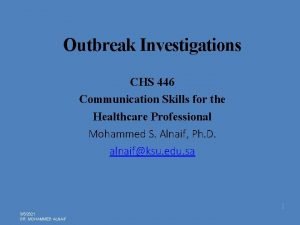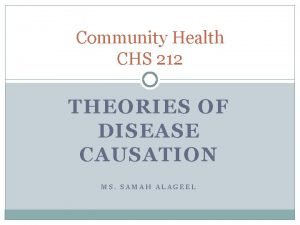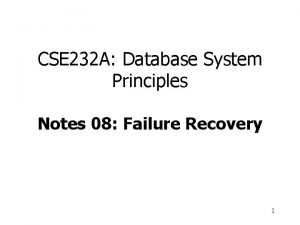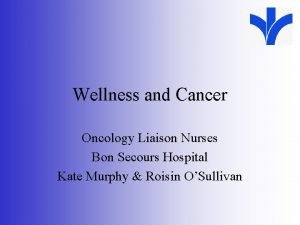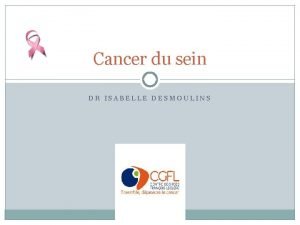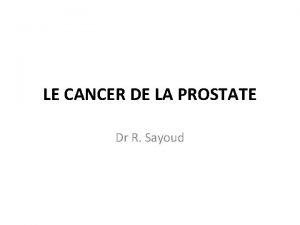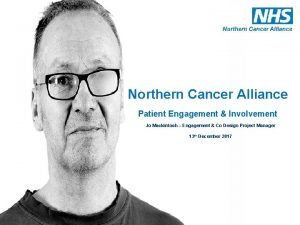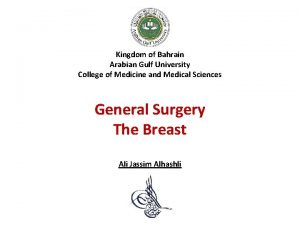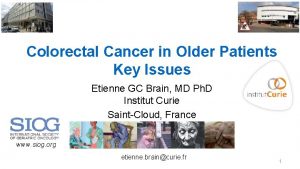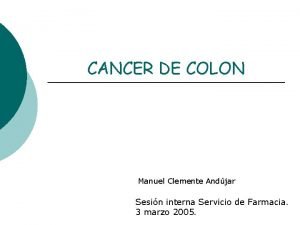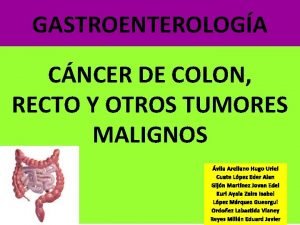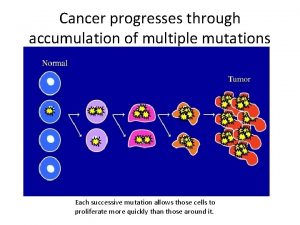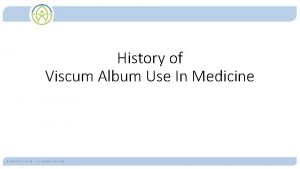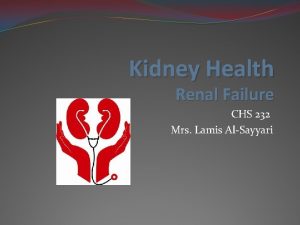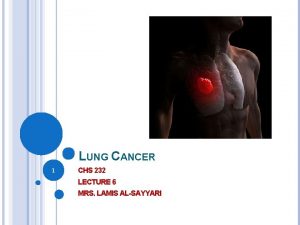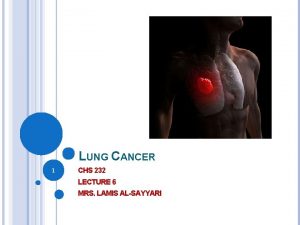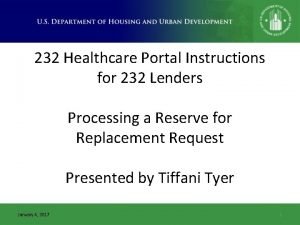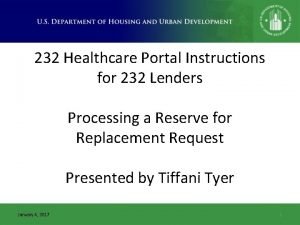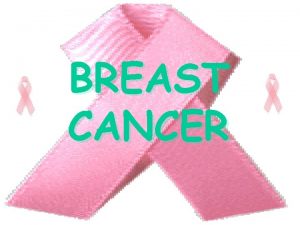1 CANCER CHS 232 LECTURE 5 MRS LAMIS



























































- Slides: 59

1 CANCER. . CHS 232 LECTURE 5 MRS. LAMIS AL-SAYYARI

2 Outline. . • Introduction about cancer disease • What is the cancer • Type of cancer • What is Breast cancer • SIGNS AND SYMPTOMS • CAUSES AND RISK FACTORS • Complications • GENERAL CARE • HOME CARE • Prevention

3 Cancer… • Cancer is a common condition and a serious health problem. More than one in three people will develop some form of cancer during their lifetime.

4 What is Cancer ? . . Cancer is the name given to a collection of related diseases. In all types of cancer, some of the body’s cells begin to divide without stopping and spread into surrounding tissues. Cancer is a universal disease that affects persons without regard to race, gender, socioeconomic status, or culture. Different forms of cancer strike specific age , ethnic, and gender groups with varying frequency and severity

5 The most common sites of fatal cancer. . Women: v Lungs v Breasts v Colon v Rectum Men: v Lung v Prostate v Colon v rectum

6

7 v Some cancers like : stomach, breast cancer, rectum, uterus, and lung occur in a familial pattern. v The causes of cancer include immunosupperssive drugs and viruses (adenoviruses, papovaviruses, herpes viruses, human T-cell lymphoma-leukemia virus, Epsteinbarr virus, and hepatitis B virus)

8 Terminology… Doubling time: means length of time for division of all tumor cells present. Direct invasion of contiguous organs or local spread: tumor cell can invade a structure such as uterus ; spreading from one organ to another. Metastasis : spread of cancer from a primary site of origin to distant organs by lymphatics or blood vessels Common sites of metastasis are the lung , liver , bones, brain

9 characteristic Benign tumor Malignant tumor Structure and differention Typical of tissue origin Atypical of tissue origin Rate of growth Usually slow May be slow, rapid, or very rapid progression Slowly progressive ( may remain stationary; may regress); rarely fatal if treated Usually progressive; almost always fatal if untreated Mode of growth Expansion (encapsulated) Infiltration and/or metastasis Tissue destruction No Common (ulceration and necrosis) Recurrence Rare Common Prognosis May be fatal if inaccessible Fatal if uncontrolled

10 STAGING AND GRADING OF CANCER v. The purpose of cancer staging and grading is to describe the extent of the malignant so that the physician can plan treatment. v. Staging should be done during the pretreatment phase of disease and after surgery if that one of the prescribed treatments. v. Clinical staging includes physical examination and evaluation of biopsy specimens.

11 STAGING AND GRADING OF CANCER v. The generally used staging system (INM) is based on measurement of primary used tumor (size, depth of penetration, invasion of adjacent structures) lymph node involvement (presence, extent, and location); and metastatic spread (presence of distant metastases).

12 Stages

13 STAGING AND GRADING OF CANCER v. Grading is histologic classification of a tumor, which is useful in determining prognosis. Cancers usually are classified as 1 (well differentiated) to 4 (poorly differentiated). The more poorly differentiated a tumor is, the less it looks like normal cells and the poorer the prognosis.

14 Types of Cancer: • Carcinomas: cancers of epithelial cell • Sarcomas: cancer of bone, muscle , or connective tissue. • Leukemias : cancers of blood-forming organs • Lymphomas: cancers of infection-fighting organs

15

Brest cancer. .

17 What is Brest Cancer. . ? • Definition : Breast cancer is a disease in which malignant (cancer) cells form in the tissues of the breast and divide and grow without control. The damaged cells can invade surrounding tissue, but with early detection and treatment, most people continue a normal life.

18 The normal Breast • A woman's breast is made up of glands that can make breast milk (lobules), small tubes that carry milk from the lobules to the nipple (ducts), fatty and connective tissue, blood vessels, and lymph vessels.

19 The lymph system of the breast The lymph system is one of the main ways breast cancer spreads. Normally, lymph nodes are small, bean-shaped tissues that contain a certain kind of immune system cell (cells that fight infections). Lymph nodes are connected by vessels (like small veins) that carry a clear fluid called lymph instead of blood. Most of the lymph vessels of the breast drain into: • Lymph nodes under the arm (axillary nodes) • Lymph nodes around the collar bone (supraclavicular and infraclavicular lymph nodes) • Lymph nodes inside the chest near the breast bone (internal mammary lymph nodes)

20

21 Lymph nodes in relation to the breast • Most breast cancers begin in the cells that line the ducts. • Fewer breast cancers start in the cells lining the lobules • Cancers can also start in cells of the other tissues in the breast. These are called sarcomas and lymphomas and are not really thought of as breast cancers.

22 Lymph nodes in relation to the breast • Breast cancer cells can travel in lymphatic vessels and begin to grow in lymph nodes. If cancer cells spread to lymph nodes, there is a greater chance that the cells have also spread to other places in the body. The chance goes up the more lymph nodes with cancer there are Since cancer in lymph nodes doesn’t always cause the nodes to get larger, doctors often remove one or more lymph nodes to check for cancer spread. • The treatment plan will depend on whether or not cancer is found in the lymph nodes.

23 Video. . • https: //www. youtube. com/watch? v=Nue. Gqr. Kn. Nc. E • https: //www. youtube. com/watch? v=Vsvi. APGf. PUo . .

24 • Breast cancer is believed to be a systemic disease , with the possibility of occult distant metastases occurring early in the disease with or without lymph node involvement.

25 HOW DO I KNOW IF I HAVE BREAST CANCER? . . .

BREAST CANCER SIGNS & SYMPTOMS

27 BUT …… WHY DOES IT HAPPEN ?

28 IT HAPPENS WHEN ….

29 IT HAPPENS WHEN …. Women with certain risk factors are more likely than others to develop breast cancer. A risk factor is something that may increase the chance of getting a disease. Some risk factors can be avoided. But most risk factors can’t be avoided. Having a risk factor does not mean that a woman will get breast cancer. Many women who have risk factors never develop breast cancer.

30 Risk factors you cannot change • Gender: Breast cancer is much more common in women than in men. • Age: risk goes up with age. • Genetic risk factors: Inherited changes (mutations) in certain genes like BRCA 1 and BRCA 2 can increase the risk. • Family history: Breast cancer risk is higher among women whose close blood relatives have this disease. • Personal history of breast cancer: A woman with cancer in one breast has a greater chance of getting another breast cancer (this is different from a return of the first cancer). • Race: Overall, white women are slightly more likely to get breast cancer than African- American women. African-American women, though, are more likely to die of breast cancer.

31 Risk factors you cannot change • Dense breast tissue: Dense breast tissue means there is more gland tissue and less fatty tissue. Women with denser breast tissue have a higher risk of breast cancer. • Certain benign (not cancer) breast problems: Women who have certain benign breast changes may have an increased risk of breast cancer. Some of these are more closely linked to breast cancer risk than others. • Lobular carcinoma in situ: In this condition, cells that look like cancer cells are in the milk- making glands (lobules), but do not grow through the wall of the lobules and cannot spread to other parts of the body. It is not a true cancer or pre-cancer, but having LCIS increases a woman's risk of getting cancer in either breast later.

32 Risk factors you cannot change • Menstrual periods: Women who began having periods early (before age 12) or who went through menopause (stopped having periods) after the age of 55 have a slightly increased risk of breast cancer. • Breast radiation early in life: Women who have had radiation treatment to the chest area (as treatment for another cancer) as a child or young adult have a greatly increased risk of breast cancer. • Treatment with DES: Women who were given the drug DES (diethylstilbestrol) during pregnancy have a slightly increased risk of getting breast cancer.

33 Breast cancer risk and lifestyle choices • Not having children or having them later in life: Women who have not had children, or who had their first child after age 30, have a slightly higher risk of breast cancer. • Certain kinds of birth control: Studies have found that women who are using birth control pills or an injectable form of birth control called depot-medroxyprogesterone acetate (DMPA or Depo-Provera®) have a slightly greater risk of breast cancer than women who have never used them. • This risk seems to go back to normal over time once the pills are stopped. • Using hormone therapy after menopause: Taking estrogen and progesterone after menopause (sometimes called combined hormone therapy) increases the risk of getting breast cancer. • This risk seems to go back to normal over time once the hormones are stopped.

34 Breast cancer risk and lifestyle choices • Not breastfeeding: Some studies have shown that breastfeeding slightly lowers breast cancer risk, especially if breastfeeding lasts 1½ to 2 years. • Alcohol: The use of alcohol is clearly linked to an increased risk of getting breast cancer. Even as little as one drink a day can increase risk. • Being overweight or obese: Being overweight or obese after menopause (or because of weight gain that took place as an adult) is linked to a higher risk of breast cancer.

35 Certain factors have been studied without finding a link to breast cancer:

36 Is having a risk factor, or even several mean that a woman will get breast cancer? ? • Although many risk factors may increase your chance of having breast cancer, it is not yet known just how some of these risk factors cause cells to become cancer. Hormones seem to play a role in many cases of breast cancer, but just how this happens is not fully understood.

37 Types of standard screening techniques of breast cancer • The term screening refers to tests and exams used to find a disease like cancer in people who do not have any symptoms. The goal is to find cancers before they start to cause symptoms. • Match!: 1. Breast Self exam 2. Clinical breast exam 3. Mammography 4. Ultrasound 5. Magnetic Resonance imaging (MRI) 6. Thermography

38 Treatment of Cancer The main types of treatment for breast cancer are: • Surgery • Radiation • Chemotherapy Chemo can be used either before or after surgery for early-stage breast cancer. This is to kill any cancer cells that may have spread but are too small to be seen by exam or tests. • Hormone therapy • Targeted therapy • Bone-directed therapy

39 Possible side effects of chemotherapy: The side effects of chemo depend on the type of drugs used, the amount given, and the length of treatment: • Hair loss • Loss of appetite or increased appetite • Nausea and vomiting • A higher risk of infection (from low white blood cell counts) • Stopping of menstrual periods • Easy bruising or bleeding (from low blood platelet counts) • Being very tired (called fatigue, often caused by low red blood cell counts or other reasons)

40 Metastases Lymphedema Hypercalcemia Pathologic fracture Spinal cord compression Pleural effusion Brachial plexopathy

41 GENERAL CARE General care for cancer patient addresses issues such as : v Loss of appetite v Nausea and vomiting v Stomatitis as a result of cancer and its treatment and the effects of cancer on the mind, body and spirit. ü The patient and caregiver should know the problems and how to manage them.

42 Loss of appetite Nausea and vomiting v Talk a walk before mealtime v Eat crackers v Avoid drinking liquids before meals v Choose cold food v Eat with family and friends v Avoid salty, sweet and spicy food v Eat a variety of food v Stay away from food odors v Eat small and frequent meals v Eat lightly v Supplements v Try relaxation therapy v Take antiemetic as prescribed

Stomatitis It is inflammation of the lining of the mouth may occur 7 to 14 days after the beginning of cancer chemotherapy or radiation therapy. v. Can be prevented or alleviated v. Use cocoa butter v. Drink cool beverages v. Wear dentures only during meals v. Maintain good oral hygiene 43

44 HOME CARE General information : Give the patient and the caregiver verbal and written instructions. Provide them with the name and telephone number of a physician or nurse to call.

45 HOME CARE Psychological care Follow-up care v Encourage discussion of feelings and emotions v Encourage discussion about side effects of the treatments v Stress the importance of verbalizing feelings about the impact of losing a body part v Encourage the patient to seek counseling v Stress the importance of regular visits v Encourage the patient to talk with another cancer survivor

46 Prevention Can breast cancer be prevented? Assess the patient level of knowledge about : Review primary prevention guidelines : v. Risk factor v. Preventive measures v. Sign and symptoms • • • ü Clarify any myths or misconceptions Smoking Sunlight Radiation Occupational hazard Alcohol Nutrition

47 Prevention -perform monthly self-examination after menstrual period -regular clinical breast examination every 3 years for women age 20 -39, and every year for women 40 and older -mammography every 1 to 2 years for ages 40 -49, and every year for ages 50 and older

48 Prevention Breast cancer v. Yearly mammograms after age 40 v. Monthly breast self examination v. Yearly clinical breast examination

49 Facts about Breast Cancer in the United States • : Breast cancer, or cancer of breast, is the most common malignancy among American women. One of seven women will have breast cancer in her lifetime.

50

51

52

53

54 IN KSA: v. The most common malignancy seen at KFSH&RC for female is breast cancer. comprising 15. 4% of all cases, as compared to 13. 9% of all neoplasms diagnosed in the U. S. A. It affects mostly women under the age of 50, while in the U. S. A. , those more than 50 years of age are most frequently affected. v. Colorectal cancer is ranked the 1 st among Saudi males.

55 IN KSA: v. For all sites, the age-specific incidence rate (AIR) increased with age for both Saudi males and females. The median age at diagnosis for men was 58 years; range (0 -122) and 51 years for women; range (0 -112). v. Between January 01 and December 31, 2012, the total number of cancer incident cases reported to the Saudi Cancer Registry (SCR) was 14, 846. Overall cancer was more among women than men; it affected 7, 048 (47. 5%) males and 7, 798 (52. 5%) females. v. The total incident cases reported among children (0 -14 years) between January and December 2012 were 851. The reported incidents show that cancer was more common among boys than girls. The leading cancer among Saudi children was Leukemia.

56 Ten Most Common Cancers among Saudis by sex, 2012

57 Percentage Distribution of Cancer Incidence among Saudis by Sex according to Age Group

58 Thank You. .

59 References: • http: //www. cancer. org/acs/groups/cid/documents/webcontent/003037 -pdf. pdf • http: //www. chs. gov. sa/Ar/Health. Records/Cancer. Registry. Repo rt 202012. pdf
 Mrs. darling was ___________ of mrs. s.
Mrs. darling was ___________ of mrs. s. They are mrs garcia and mrs castro
They are mrs garcia and mrs castro They are mrs garcia and mrs castro
They are mrs garcia and mrs castro Cms.edf.school
Cms.edf.school Chs or ibs
Chs or ibs Chs module
Chs module Maryland integrated science assessment
Maryland integrated science assessment Chs statistics
Chs statistics J'chs 2
J'chs 2 Chs lancers
Chs lancers Chs investigations
Chs investigations Lba to chs
Lba to chs St robert guidance
St robert guidance Chs investigations
Chs investigations Chs scaffolding
Chs scaffolding Example of chs theories
Example of chs theories 01:640:244 lecture notes - lecture 15: plat, idah, farad
01:640:244 lecture notes - lecture 15: plat, idah, farad Definition of lami's theorem
Definition of lami's theorem Lagu cilikanku rambutku dicukur kuncung
Lagu cilikanku rambutku dicukur kuncung Varigons theorem
Varigons theorem Varignon's theorem examples
Varignon's theorem examples Forces of equilibrium
Forces of equilibrium Bus 232 floridsdorf fahrplan
Bus 232 floridsdorf fahrplan The possessive adjectives modify nouns en español
The possessive adjectives modify nouns en español Ucsd cse 232
Ucsd cse 232 Cse 232
Cse 232 Ashoka 232
Ashoka 232 254 en yakın yüzlüğe yuvarlama
254 en yakın yüzlüğe yuvarlama Eia-232-d
Eia-232-d Actsc 445
Actsc 445 Arth 232
Arth 232 Cse 232
Cse 232 Republic act 4670 reflection
Republic act 4670 reflection Cse 232
Cse 232 Cse232
Cse232 Amdahl's law
Amdahl's law Conector rs-232
Conector rs-232 232 bc
232 bc 156+232
156+232 Usd 232
Usd 232 Batas pambansa 232 education act of 1982
Batas pambansa 232 education act of 1982 Cse232
Cse232 Mrm incision
Mrm incision Reflexology for cancer
Reflexology for cancer Photos cancer inflammatoire
Photos cancer inflammatoire Hormonothérapie cancer prostate
Hormonothérapie cancer prostate Tropic of cancer and capricorn
Tropic of cancer and capricorn Cancer is mitosis gone wild
Cancer is mitosis gone wild Ralph steinman pancreatic cancer
Ralph steinman pancreatic cancer Cancer du col
Cancer du col Cancer du col
Cancer du col Northern cancer alliance
Northern cancer alliance Gulf university
Gulf university Colon cancer kras wild type
Colon cancer kras wild type Cancer de colon
Cancer de colon Kennings for a hero
Kennings for a hero Clasificacion de dukes cancer colon
Clasificacion de dukes cancer colon Cancer biomedicine
Cancer biomedicine Cancer mutations
Cancer mutations Cancer burden of disease
Cancer burden of disease













